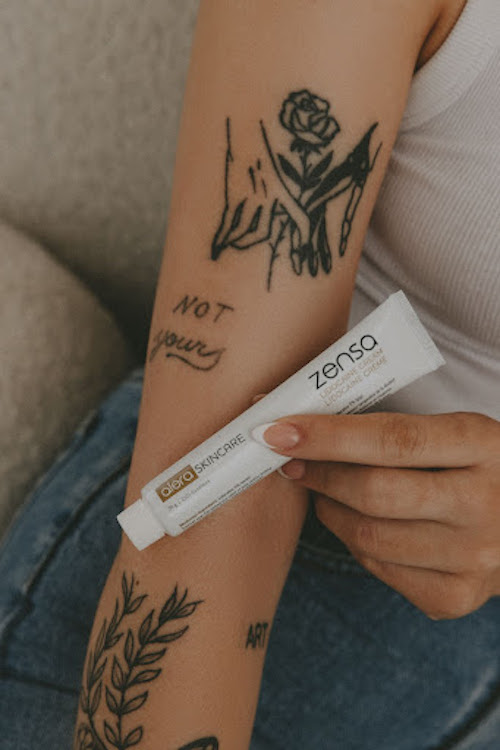
Okay, let’s dive into whether you can bring numbing cream to your tattoo appointment.
Ever wondered if you could make that tattoo session a little less… ouchy?
Like, is it even allowed?
Will your artist judge you?
Does it actually work?
I get it.
Tattoos are awesome, but the pain?
Not so much.
So, can I take numbing cream to my tattoo session? Let’s get into it.
Numbing Cream and Tattoos: The Real Deal
First things first, it’s totally normal to want a less painful tattoo experience.
Nobody’s judging you for wanting to chill out a bit.
I’ve seen people sweat bullets just thinking about the needle.
I remember my friend, Sarah, who almost bailed on her first tattoo because she was so scared of the pain.
Luckily, she used numbing cream and got through it like a champ!
But here’s the thing: not all artists are cool with it.
Checking with Your Tattoo Artist
Before you even think about slathering on some numbing cream, talk to your tattoo artist.
Seriously.
This is the most important step.
Every artist has their own preferences and experiences with numbing agents.
Some are totally on board, while others have had bad experiences (like the cream interfering with the ink or the skin’s texture).
Here’s why chatting with your artist is crucial:
- They know what works best for their style: Different inks and techniques react differently with numbing creams.
- They can recommend specific products: Some creams are better than others, and your artist might have a favorite.
- They can advise on application: Timing is everything! Applying the cream too early or too late can affect its effectiveness.
- They can avoid potential problems: Some numbing creams can make the skin swell or change its texture, which can make it harder for the artist to work.
Think of it this way: your artist is the expert here.
They want you to have a good experience and a great tattoo.
Working together is key.
Types of Numbing Cream: What’s Out There?
Okay, so you’ve talked to your artist and they’re cool with numbing cream.
Now what?
Well, there are a few different types to choose from:
- Lidocaine: This is the most common ingredient in topical numbing creams. It works by blocking nerve signals in the area where it’s applied.
- Tetracaine: A stronger anesthetic than lidocaine, but it can also have more side effects.
- Benzocaine: Another common topical anesthetic, often found in over-the-counter products.
- Combination Creams: Many creams combine lidocaine with other ingredients to enhance the numbing effect or reduce inflammation.
Important: Always read the labels carefully and follow the instructions.
And again, ask your artist for recommendations.
They might have tried different brands and know which ones work best.
How to Apply Numbing Cream Correctly
So, you’ve got the green light and the right cream.
Now, let’s talk application.
This is where things can get a little tricky.
Here’s a general guide, but remember, always follow the instructions on the product label and your artist’s advice:
- Clean the area: Wash the skin with soap and water and dry it thoroughly.
- Apply a thick layer: Don’t be shy! Apply a generous amount of numbing cream to the area where you’ll be tattooed.
- Cover with occlusive dressing: Wrap the area with plastic wrap or a similar occlusive dressing to help the cream absorb into the skin.
- Wait: This is the hardest part! Most creams take about 30-60 minutes to start working.
- Wipe off the excess: Just before your tattoo session starts, wipe off the excess cream with a clean paper towel.
Pro Tip: Apply the cream in a well-ventilated area to avoid inhaling the fumes.
Potential Downsides of Using Numbing Cream
While numbing cream can be a lifesaver, it’s not without its potential drawbacks.
- It might not work for everyone: Some people are less sensitive to topical anesthetics than others.
- It can affect the skin: Some creams can cause swelling, redness, or changes in skin texture.
- It can interfere with the ink: In rare cases, numbing cream can affect how the ink is absorbed by the skin.
- It can be expensive: High-quality numbing creams can be pricey.
- Allergic reactions: Always test a small area first to make sure you don’t have an allergic reaction.
I’ve heard stories of people who used numbing cream and ended up with a tattoo that didn’t heal properly.
That’s why it’s so important to talk to your artist and follow their instructions carefully.
Can I take numbing cream to my tattoo session? (Recap)
So, to circle back to the original question: Can I take numbing cream to my tattoo session?
The answer is usually yes, with conditions.
Always check with your artist first, choose the right cream, and apply it correctly.
It’s all about open communication and doing what’s best for your skin and your tattoo.
FAQ About Numbing Cream and Tattoos
-
Will numbing cream completely eliminate the pain of a tattoo?
- Probably not completely, but it can significantly reduce the pain. Think of it like taking the edge off.
-
Is it safe to use numbing cream on all areas of the body?
- Some areas are more sensitive than others. Talk to your artist about whether numbing cream is appropriate for the area you’re getting tattooed.
-
Can I use numbing cream on a tattoo I already have?
- It’s generally not recommended to use numbing cream on an existing tattoo, especially if it’s still healing. If you’re experiencing pain or discomfort, talk to your tattoo artist or a healthcare professional.
-
What if my tattoo artist says no to numbing cream?
- Respect their decision. They likely have a good reason for it.
-
Where can I buy numbing cream?
- You can find numbing cream at most pharmacies, online retailers, and some tattoo supply shops. Always buy from a reputable source.
Leave a Reply